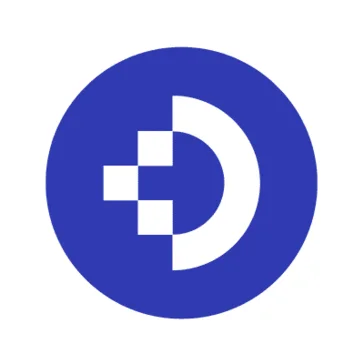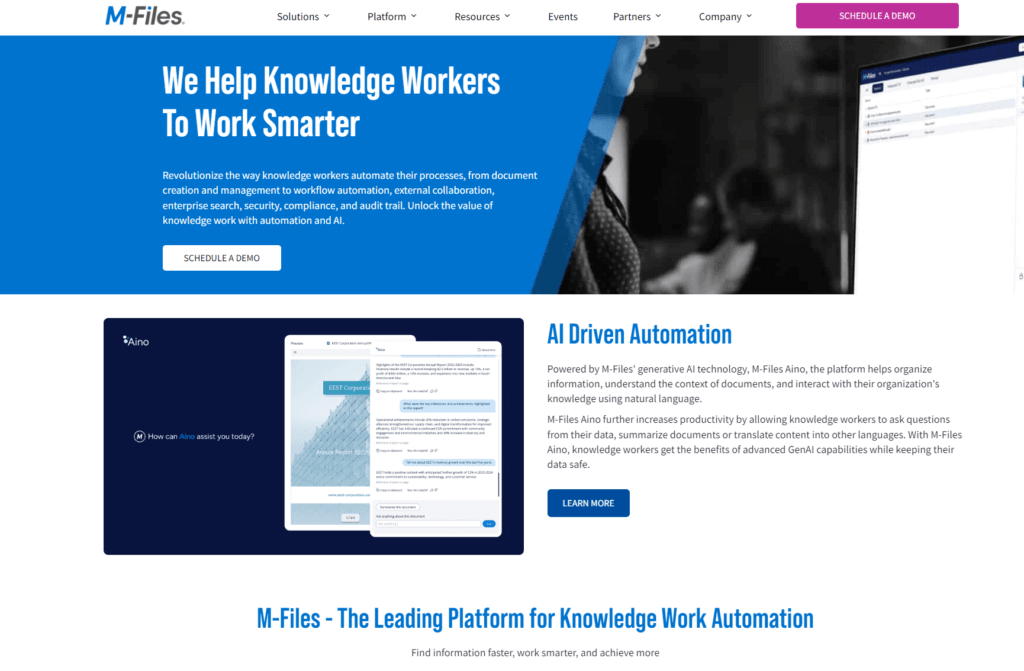Navigating the world of document management systems (DMS) can feel like trying to find your way through a dense forest with just a compass. Among the towering trees, M-Files and DocuWare stand out like two beacons, offering paths to organizational efficiency and streamlined workflows. But which beacon should you follow? This isn’t just about choosing a document management system; it’s about finding the right partner to help your business manage its most valuable asset—information. Let’s embark on this journey to uncover which tool, M-Files or DocuWare, is the best fit for your business needs, starting with a crucial factor: Usability.
| M-Files | DocuWare |
|---|---|
 |  |
| G2 Score -4.3 out of 5 | G2 Score -4.5 out of 5 |
| TrustRadius Score -9.2 out of 10 | TrustRadius Score -9.2 out of 10 |
Usability: The Ease of Your Journey
In any software, especially one as integral to your daily operations as a document management system, usability is key. You want a tool that not only promises a plethora of features but is also easy for your team to adopt and use. Let’s delve into how M-Files and DocuWare each handle the user experience.
M-Files: A Unique, Intelligent Approach
M-Files takes a distinctive approach to document management. It doesn’t just organize your documents; it intelligently understands what each document is about. By focusing on the content and context of documents rather than where they’re stored, M-Files aims to revolutionize how you find and interact with your information.
Its interface is designed around this philosophy, offering a dynamic way to access documents based on what they are—a contract, an invoice, a project file—rather than by browsing through folders. This might sound complex, but M-Files has worked hard to ensure that its user interface remains intuitive, guiding users through its unique system with ease.
The transition to M-Files’ metadata-driven system may require some initial adjustment, especially for teams accustomed to traditional folder structures. However, the platform offers comprehensive support and training resources to smooth out the learning curve, making it a potentially transformative tool for businesses willing to adapt for greater long-term efficiency.
DocuWare: Familiarity Meets Innovation
DocuWare, on the other hand, marries innovation with familiarity, offering a document management solution that feels intuitive from the get-go. It builds on the conventional folder-based organization system but enhances it with powerful search capabilities, automated workflows, and digital forms. This makes DocuWare immediately accessible to new users while still offering the depth and functionality needed for complex document management tasks.
What sets DocuWare apart is its commitment to a user-friendly experience across all its features. From straightforward document capture and indexing to setting up detailed workflows, DocuWare provides a clear, guided process. Its interface is clean and uncluttered, ensuring that users of all tech levels can navigate and utilize the system effectively with minimal training.
Integration Capabilities: The Connective Web of Your Digital Ecosystem
In the digital age, a document management system doesn’t operate in isolation. It’s part of a broader ecosystem of business applications, each serving distinct but interconnected functions. Let’s assess how well M-Files and DocuWare integrate with other software, becoming a central node in your business’s digital network.
M-Files: Seamlessly Blending with Your Tools
M-Files shines when it comes to integration, primarily due to its API-first approach. This philosophy ensures that M-Files can connect with a wide array of applications, from CRM and ERP systems to productivity tools and beyond. M-Files doesn’t just coexist with these applications; it enhances their functionality by providing immediate access to documents and information directly within the workflow of other software.
Moreover, M-Files offers a variety of pre-built connectors for popular business applications, making the integration process as smooth as possible. For businesses with custom-built software or unique integration needs, M-Files’ flexible API allows for tailored solutions, ensuring that no matter how niche or specific your software ecosystem is, M-Files can adapt and integrate effectively.
DocuWare: Streamlining Workflows Across Applications
DocuWare also understands the importance of integrations in modern business operations. It provides robust support for connecting with a range of third-party applications, ensuring that document management becomes a seamless part of your existing workflows. With support for major ERP and CRM systems, as well as productivity suites like Microsoft Office 365, DocuWare positions itself as a versatile player in the digital ecosystem.
One of DocuWare’s strengths is its ability to automate document-driven processes by leveraging these integrations. Whether it’s pulling data from forms into your CRM or linking documents to specific records in your ERP system, DocuWare makes it easy to bridge the gap between documents and the applications that rely on them. This focus on process automation, powered by integration, can significantly reduce manual work and enhance efficiency across departments.
Pricing: The Investment in Efficiency
A transparent and flexible pricing model not only affects your initial decision but also impacts long-term satisfaction with your document management system. Let’s compare the pricing strategies of M-Files and DocuWare.
M-Files: Tailored Pricing for Custom Needs

M-Files adopts a tailored approach to pricing, reflecting its emphasis on customization and adaptability. Recognizing that no two businesses have identical document management needs, M-Files prefers to provide personalized quotes rather than one-size-fits-all pricing tiers. This approach ensures that companies pay for exactly what they need, without unnecessary extras inflating the cost.
The pricing for M-Files generally depends on several factors, including the number of users, the level of customization required, and the specific features and integrations your organization needs. M-Files also offers options for both cloud-based and on-premises deployments, which can affect the overall cost.
While this customized pricing model offers the advantage of paying for precisely what you need, it does mean that businesses must engage in detailed discussions with M-Files representatives to get a clear understanding of potential costs.
DocuWare: Transparent, Tiered Pricing

In contrast to M-Files, DocuWare provides a more straightforward, tiered pricing structure that’s accessible directly from its website. This transparency allows businesses to quickly gauge the cost of implementing DocuWare within their operations. The pricing tiers are designed to cater to a wide range of business sizes and needs, from small teams looking for basic document management functionalities to large enterprises requiring advanced features and integrations.
DocuWare’s pricing typically includes various levels, each offering an increasing number of features, storage capacities, and user access options. This clear, tiered approach simplifies the decision-making process for businesses by allowing them to easily compare different plans and select the one that best fits their needs and budget.
Security and Compliance: Safeguarding Your Digital Assets
In an era where data breaches are costly and non-compliance can result in severe penalties, the security and compliance features of your DMS play a foundational role in your organization’s overall data governance strategy. Here’s how M-Files and DocuWare ensure your information remains secure and compliant.
M-Files: Precision in Protection and Compliance
M-Files approaches security with a multifaceted strategy designed to protect data at every turn. Utilizing advanced encryption for data at rest and in transit, M-Files ensures that your documents are inaccessible to unauthorized users. Beyond encryption, it offers dynamic permission settings, allowing administrators to finely tune access based on roles, projects, or even specific document types, thereby minimizing the risk of internal data leaks.
Compliance in M-Files is handled with an equal level of seriousness. The platform offers features tailored to help organizations comply with a wide range of regulatory requirements, including GDPR, HIPAA, and ISO standards. From automating record retention schedules and ensuring proper document lifecycle management to providing comprehensive audit trails, M-Files equips businesses with the tools needed to maintain compliance and prepare for audits efficiently.
DocuWare: Comprehensive Security with Streamlined Compliance
DocuWare’s security framework is robust, offering comprehensive measures to safeguard your documents. Like M-Files, it provides strong encryption methods and detailed permission settings to control access to sensitive information. DocuWare also features secure document transmission capabilities, ensuring that files remain protected not only when stored but also when shared both internally and externally.
On the compliance front, DocuWare simplifies the complex landscape of regulatory adherence. It offers integrated records management functionalities that automate the retention and disposal of documents in compliance with legal requirements. Additionally, DocuWare’s audit trail capabilities record every action taken on a document, providing transparency and accountability that can prove invaluable during compliance audits.

Related: Check out our free SEO suite

Scalability and Future-Proofing: Preparing for Tomorrow
A document management system that’s a perfect fit today needs to be able to meet your business’s demands tomorrow. Here’s how M-Files and DocuWare ensure your investment is not just for the present but also for the future.
M-Files: Adaptability at Its Core
M-Files is designed with a strong emphasis on adaptability and growth. Its unique approach to document management, focusing on metadata rather than traditional file paths, inherently allows for greater scalability. This system doesn’t just scale in terms of document volume but also in complexity and sophistication of document management needs.
As your business grows, M-Files can easily accommodate new document types, workflows, and compliance requirements without necessitating a complete overhaul of your document management infrastructure. Its flexible architecture and extensive API support mean that integrating new tools, systems, and processes is straightforward, ensuring that M-Files not only grows with your business but also enhances its evolution.
Furthermore, M-Files offers a variety of deployment options, including cloud, on-premises, and hybrid models, providing businesses with the flexibility to scale their document management solution in a way that best fits their evolving IT strategy and requirements.
DocuWare: Robust and Ready for Growth
DocuWare presents a robust platform that’s ready to support your business’s growth from day one. Its cloud-based nature ensures that scalability in terms of users, storage, and processing power is inherently built into the system. Businesses can easily add more users or increase storage capacity as needed, without significant upfront investments in hardware or infrastructure.
DocuWare also emphasizes future-proofing through continuous updates and improvements to its platform, adding new features and capabilities that reflect the latest trends in document management and workflow automation. This commitment to innovation means that DocuWare users can be confident their system will remain on the cutting edge, providing tools and functionalities that meet both current and future needs.
Moreover, DocuWare’s extensive library of integrations and modular add-ons allows businesses to expand their document management capabilities as new needs arise, ensuring the platform remains a valuable asset through various stages of growth and development.
Conclusion
Deciding whether M-Files or DocuWare is the best document management tool for your organization hinges on several factors. Consider your business’s current and future needs, the level of customization and integration you require, your security and compliance priorities, budget constraints, and plans for growth.
READ NEXT:
- Delivra vs ReachMail: The Best Email Marketing Tool for You
- Delivra vs BenchmarkONE: The Best Email Marketing Tool for You
- 21+ Top Document Management Software for Businesses: A Deep Dive
- Revver vs Google Drive for Work: The Best Document Management Tool for You
- DocuWare vs Google Drive for Work: The Best Document Management Tool for You
- Baremetrics vs Heap: The Best Analytics Tool for You






















Comments are closed.